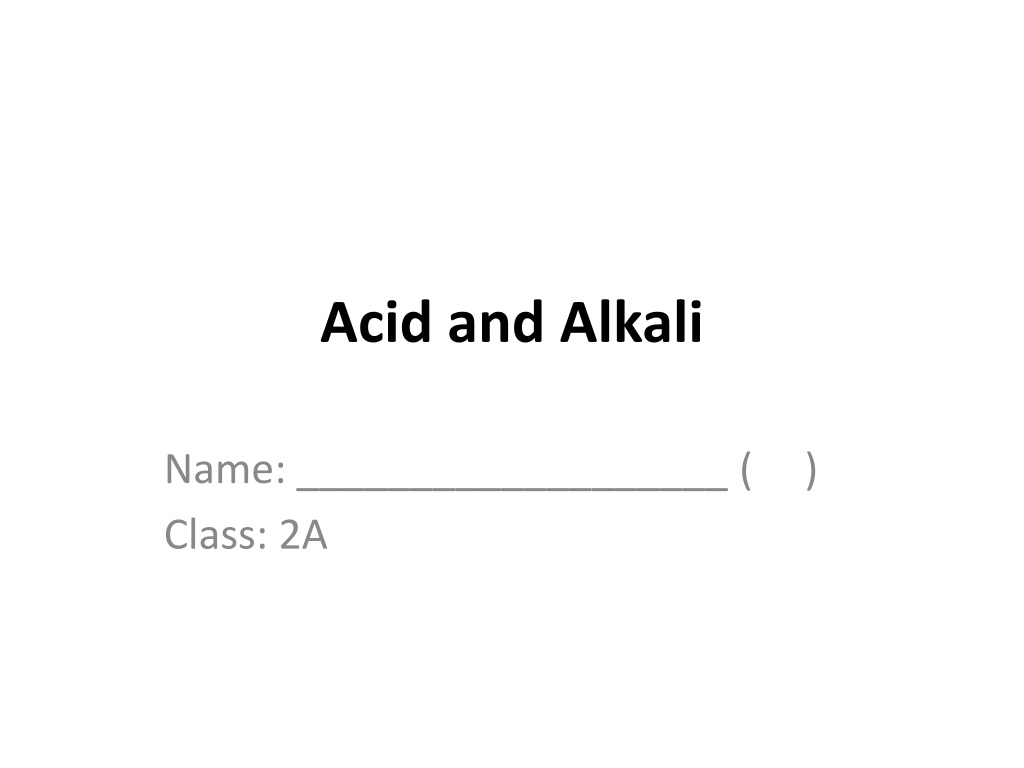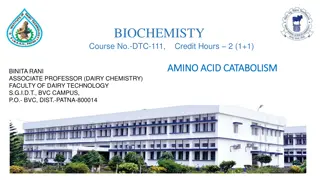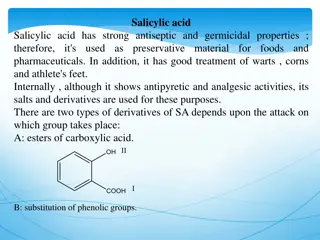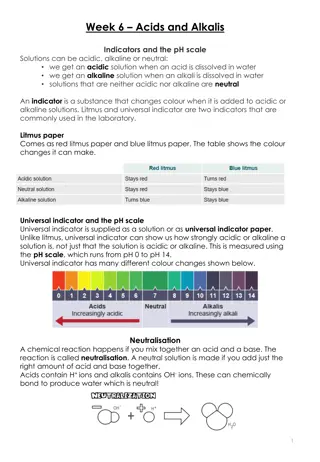Understanding Acid and Alkali Reactions
Explore the effects of acid rain on soil and ecosystems, learn about pH measurements in solutions, and witness the reactions of litmus paper with acids and alkalis. Follow the journey of an environmental consultant assisting a farmer facing plant growth issues on his farm.
Download Presentation

Please find below an Image/Link to download the presentation.
The content on the website is provided AS IS for your information and personal use only. It may not be sold, licensed, or shared on other websites without obtaining consent from the author. Download presentation by click this link. If you encounter any issues during the download, it is possible that the publisher has removed the file from their server.
E N D
Presentation Transcript
Acid and Alkali Name: ___________________ ( ) Class: 2A
Acidic gases dissolve with water droplets in clouds 2 Acid rain Water droplets falls as acid rain 3 Acidic gases such as sulfur dioxide and oxides of nitrogen released into the air 1 2
Acid Rain Effects: Acidification of soil, ocean and sea Soil becomes acidic and affects growth of plants Sea creatures affected as sea and ocean becomes acidic Corrode buildings made of metal and calcium carbonate Loss of heritage buildings
pH pH is a measurement of solution to determine if it is acid, alkali or neutral. Teacher s demo with Universal indicator: Solution Colour of universal indicator pH Acid red 1-3 Alkali blue 10-12 Water Green 7-8
Acid and Alkali Place a piece of blue litmus paper and red litmus paper on a clean filter paper. Using dropper 1, place a drop of hydrochloric acid on both strips of litmus papers. Record your observation: Blue litmus paper: turns red Red litmus paper: remains the same
Acid and Alkali Place a piece of blue litmus paper and red litmus paper on a clean filter paper. Using dropper 2, place a drop of sodium hydroxide on both strips of litmus papers. Record your observation: Blue litmus paper: remains the same Red litmus paper: turns blue
Acid and alkali pH 1-6: Acid pH 7: Neutral pH 8-14: Alkali
Acid and alkali Universal indicator orange/ yellow purple red blue green 1 2 3 4 5 6 7 8 9 10 11 12 13 14 Acid Alkali Neutral Turn blue litmus paper red Turn red litmus paper blue Litmus paper test
Scenario Imagine you are an environmental consultant. Farmer Bob has a farm which has been experiencing poor plant growth over the past 2 years. He decided to consult you regarding this.
Identify problem You have been provided Sample X, a sample of the soil from the farm. Conduct necessary tests to determine the problem.
Identify problem Place a piece of blue litmus paper and red litmus paper on a clean tile. Using dropper 3, place a drop of Sample X on both strips of litmus papers. Record your observation: Blue litmus paper: turns red Red litmus paper: remains the same Conclusion: The soil is * acidic/alkali (circle the correct answer)
Recommendation Farmer Bob should add alkali solution to gradually increase the pH of the soil to pH 7. This process is called neutralisation.
Neutralisation 1. Using a syringe, add 1 ml of soil sample X into a test tube. 2. Put 2 drops of Universal indicator. (Colour of Universal indicator: ____red___) 3. Shake the test tube. 4. Using a dropper, add sodium hydroxide drop by drop until it changes colour. Shake the test tube after every drop. 5. After it changes colour, allow it to stand for 2-3 minutes.
Neutralisation Results: No of drops needed: ____ Observation: Universal indicator changes colour from _red_ to __blue__. After a few minutes, it changes colour to _green_. Conclusion: Soil sample change from ___1-3___ to ____7____.
Conclusion For every 1 ml of soil, Farmer Bob should add ____ drops of sodium hydroxide to neutralise the soil.























